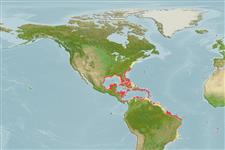Environment: milieu / climate zone / depth range / distribution range
экология
морской ассоциированный с рифами; пределы глубины 2 - 50 m (Ref. 7345), usually 2 - 18 m (Ref. 27115). Tropical; 43°N - 27°S, 100°W - 4°W (Ref. 55165)
Western Atlantic: New York, USA and Bermuda to the Gulf of Mexico and Brazil. Eastern Atlantic: Ascension Island (Ref. 7345).
Length at first maturity / Size / Вес / Возраст
Maturity: Lm ?, range 13 - ? cm
Max length : 39.0 cm TL самец/пол неопределен; (Ref. 36453); common length : 25.0 cm TL самец/пол неопределен; (Ref. 5217)
колючие лучи спинного плавника (общее число) : 9; членистые (мягкие) лучи спинного плавника (общее число) : 26 - 28; колючие лучи анального плавника: 3; членистые (мягкие) лучи анального плавника: 24 - 26. A deep-bodied surgeonfish (body depth 1.7 in SL) with a conspicuous yellow caudal spine. Has the most distinctive coloration of all western Atlantic surgeonfishes (Ref. 26938).
Inhabits coral reefs, inshore grassy or rocky areas. Forms small groups (Ref. 26235). Mainly diurnal. Feeds entirely on algae (Ref. 5521). At Fernando de Noronha Archipelago in southwestern Atlantic, juveniles hold cleaning stations together with the doctorfish (Acanthurus chirurgus) and sergeant major (Abudefduf saxatilis) and graze algae as well as pick molted skin and parasites from green turtles (Chelonia mydas). This behavior is preceded by a characteristic inspection usually followed by feeding nips on the turtles’ skin (head, limbs, and tail), as well as on the carapace. The most inspected and cleaned body parts are the flippers (Ref. 51385). Diurnal species (Ref. 3194). It forms resident spawning aggregations in late afternoon after high tide (Ref. 27825, 120681, 120682). The spine on both sides of the caudal peduncle may inflict painful wounds (Ref. 5217). Marketed fresh. Maximum depth reported taken from Ref. 127989.
Life cycle and mating behavior
Maturities | размножение | Spawnings | Egg(s) | Fecundities | личинки
Robins, C.R. and G.C. Ray, 1986. A field guide to Atlantic coast fishes of North America. Houghton Mifflin Company, Boston, U.S.A. 354 p. (Ref. 7251)
Статус Красного Списка МСОП (Ref. 130435)
Угроза для людей
Traumatogenic (Ref. 4690)
Использование человеком
рыболовство: не имеет хозяйственного значения; аквариум: коммерческий; наживка: occasionally
дополнительная информация
инструменты
Специальные отчеты
Скачать в формате XML
ресурсы в Интернет
Estimates based on models
Preferred temperature (Ref.
123201): 23.7 - 28.1, mean 27.4 °C (based on 783 cells).
Phylogenetic diversity index (Ref.
82804): PD
50 = 0.5000 [Uniqueness, from 0.5 = low to 2.0 = high].
Bayesian length-weight: a=0.02570 (0.01558 - 0.04242), b=2.95 (2.81 - 3.09), in cm total length, based on LWR estimates for this species & Genus-body shape (Ref.
93245).
Trophic level (Ref.
69278): 2.2 ±0.00 se; based on food items.
Generation time: 9.8 ( na - na) years. Estimated as median ln(3)/K based on 2
growth studies.
устойчивость к внешним воздействиям (Ref.
120179): средний (среднего размера), минимальное время удвоения популяции 1.4-4.4 года (K=0.11-0.50).
Fishing Vulnerability (Ref.
59153): High vulnerability (59 of 100).
Nutrients (Ref.
124155): Calcium = 53.4 [22.4, 151.6] mg/100g; Iron = 0.729 [0.281, 1.754] mg/100g; Protein = 18.3 [17.0, 19.5] %; Omega3 = 0.102 [0.047, 0.213] g/100g; Selenium = 19.2 [6.8, 55.4] μg/100g; VitaminA = 36.2 [8.8, 136.0] μg/100g; Zinc = 2.59 [0.82, 4.74] mg/100g (wet weight);
